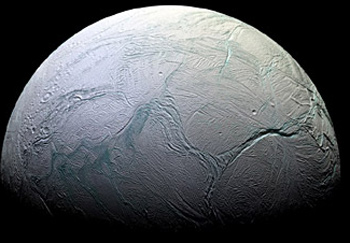Ocean discovered on two Saturn satellites
Images sent by Cassini's probe show evidence of ocean and ice volcanic existence on Saturn's Enceladus and Titan satellites. In addition, Enceladus' surface has the same stretch of Earth.

Enceladus' southernmost cracks show that its surface is stretching like the Earth.Photo: NASA.
The information was published at a meeting of the American Physical Geological Union in San Francisco on December 15. The phenomenon of the ocean floor on Earth is stretching into many plaques and moving in different directions is considered one of the greatest scientific discoveries in the 20th century. array.
Cassini now finds a similar phenomenon on Enceladus, Saturn's seventh satellite by distance. The surface of this satellite has many southern cracks, like dark stripes on tiger skin. They reinforce the assumption that Enceladus used to have a sea.
Dr. Paul Helfenstein of Cornell University - one of the scientists involved in the exploration of Saturn's satellites - uses digital maps of the area to reconstruct the process of cracking. He let the pieces move on the computer screen until they fit together like in a jigsaw puzzle. Paul found the pieces once a unified block.
'The upper part of the Earth's crust moves in a symmetrical manner. As for Enceladus, we see arrays shifting in one direction , "Paul said.
The ocean floor on Earth is stretched by the eruption of molten lava below. Scientists predict that the plates on Enceladus' surface can be stretched by the action of water. "We have evidence that liquid water exists on Enceladus ," said Carolyn Porco, one of the scientists involved in the study of Saturn's satellites.
If this hypothesis proves correct, Enceladus will become one of the most attractive exploration targets in the future. Scientists have been able to gather evidence that Enceladus has some of the chemicals needed for life's formation. Water is the last piece to create a complete picture.

Titan - Saturn's largest satellite.Photo: NASA.
Also on December 15, NASA announced images of Titan - Saturn's largest satellite - captured by Cassini with radar equipment. They show that Titan may have ice volcanoes that are or have been active. On the photos, scientists see the currents on Titan's surface. They argue that they are the result of cold solution eruption below the crust.
In a number of past flights through Titan, Cassini captured many images showing the existence of ice volcanoes on the satellite. Scientists believe that Titan's volcanoes spew ammonia (NH 3 ), methane (CH 4 ) and water, not volcanic lava on the planet.
'Images show that ice volcanoes not only exist on Titan in the past, but they may continue to function today,' said Jonathan Lunine, an expert at the University of Arizona (USA).
Titan is one of the few celestial bodies in the solar system that has a relatively thick atmosphere. Scientists believe that methane has created clouds and rain on Saturn's largest satellite. However, the origin of methane is still a mystery. Experts believe that the phenomenon of methane spray from inside the Titan's shell is the cause of its smog-like atmosphere.
Spectrum analyzer on Cassini detected bright spots in two areas on Titan's surface. In one area, scientists found evidence of the existence of ammonia mist. They thought it sprayed up from the ground.
Cassini probe is the result of a collaboration between NASA, the European Space Agency and the Italian Space Agency. It began flying around Saturn since 2004 to study the planet's gas and satellite rings.
- Under the surface of Saturn's Mimas satellite may be an ocean
- The best picture of Saturn's UFO-like satellite
- Saturn overtakes Jupiter with the number of orbiting satellites
- March 25, 1655: Discovering Saturn's largest satellite is Titan
- Signs of water on Saturn satellite
- Detecting Saturn satellite has the same smell as
- Close up of Saturn and satellites
- The first close-up photo of a Saturn satellite
- There may be an ocean hidden deep beneath the crust of the moon Enceladus
- Overview of Saturn
- Saturn's satellites have air
- Saturn changes color seasonally
 Van Allen's belt and evidence that the Apollo 11 mission to the Moon was myth
Van Allen's belt and evidence that the Apollo 11 mission to the Moon was myth The levels of civilization in the universe (Kardashev scale)
The levels of civilization in the universe (Kardashev scale) Today Mars, the sun and the Earth are aligned
Today Mars, the sun and the Earth are aligned The Amazon owner announced a secret plan to build a space base for thousands of people
The Amazon owner announced a secret plan to build a space base for thousands of people